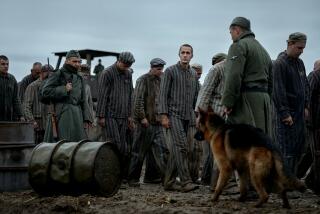A view of WWII, in full color
- Share via
The flag-raising on Iwo Jima, soldiers streaming ashore at Normandy Beach on D-Day, Adolf Hitler reviewing his goose-stepping army: All are iconic images from WWII, engraved in our collective national memory in grainy black and white.
But our view of the conflicts from the first half of the last century is about to undergo a dramatic, chromatic reconception. The next two Wednesdays, KCET is airing a four-part documentary series, “The Perilous Fight: America’s World War Two in Color,” that allows viewers to see the war in a full rainbow of hues.
Made up of original footage, much of it the home movie variety, the series starts with a 1919 parade in Paris celebrating victory in World War I and ends with jubilant crowds thronging Manhattan streets at the end of World War II. Altogether, it provides views of World War II that few besides those who actually fought have ever seen.
“Black and white puts distance between the viewer and the screen,” says cinematographer Janusz Kaminski, who filmed “Saving Private Ryan.” “It feels like you’re watching events that happened a long, long time ago. In color, it looks immediate. It looks real.”
The co-production, by Britain’s TWI/Carlton TV with Seattle PBS station KCTS, has been years in the making, as series producer Martin Smith and archive film producer Adrian Wood, with KCTS’ in-house research team, engaged in a worldwide scavenger hunt for color footage that took them from the locked archives of the Soviet Union to a dumpster in Long Beach.
Narrated by Martin Sheen, “The Perilous Fight” features footage shot by such Hollywood luminaries as John Ford, Frank Capra and George Stevens, who served in the Armed Forces during the Second World War and who, according to UCLA School of Theater, Film and TV professor Jonathan Kuntz, had their first opportunities to photograph in color then. The series also features the work of dozens of anonymous battlefield cinematographers and other people.
Inspired by Ken Burns’ “Civil War” series and HBO’s “Dear America: Letters from Vietnam,” the filmmakers sought film footage, photos and documents of ordinary Americans, putting out the call through veterans’ organizations, computer lists and letter-writing campaigns.
More than 60 small film archives and history museums across the United States answered the call with small amounts of color footage and personal documents.
One great find was the immense film archive of Francis Line, a wealthy Southern Californian who, as a hobby, filmed travelogues of American and Asian life in the 1930s. His footage was rescued from a dumpster by an antiques dealer and later purchased by Long Beach videographers Grace McKay and Emmett Kesel. Kuntz says that “ironically, by the late 1930s, amateurs were using color film even more freely than Hollywood.”
Film archive researcher Wood, inspired by viewing the 1974 TV documentary series “The World at War,” which featured a small amount of color footage, kept his eyes open for color footage as he made research trips around the globe. One late 1980s trip, to a previously off-limits Soviet film archive, revealed WWII footage shot with a three-strip color system similar to Technicolor.
Eventually, Wood realized that he’d found enough unseen footage of the war to make an entire documentary in color, an idea he initially developed with TWI executive producer Stewart Binns. Later visits to the National Archive and Records Administration in Washington, D.C., uncovered another treasure trove of color footage. “The NARA is America’s cultural patrimony,” enthuses Wood. “It’s a marvelous institution and, without question, one of the largest and most successful archive footage resources in the world.”
For WWII veterans, the documentary series may revive old memories. For the rest of us, seeing “The Perilous Fight’s” color footage will make the realities of WWII more vivid and -- especially for the younger generation -- close the gap between more recent wars and this historic conflict.
“Sixty years later, this will add a whole new viewpoint on the war for people today,” UCLA’s Kuntz says. “This footage could have a tremendous impact on viewers.”
“For the younger generation, this is a war of the past,” Kaminski says. “If they see it in color, the significance and the horror of war will become much more immediate.”
More to Read
The complete guide to home viewing
Get Screen Gab for everything about the TV shows and streaming movies everyone’s talking about.
You may occasionally receive promotional content from the Los Angeles Times.






